Botsuana - Tumblr Posts - Page 3
Botswana ist ein weites Binnenland mit einem Umfang von circa 582 000 Quadratkilometern. Zwei Drittel des Landes bestehen aus der Kalahari Wüste. Sehenswürdigkeiten sind unter anderem der Chobe Nationalpark, das Moremi Wildtierreservat, das Okavongo Delta, die Linyanti Sümpfe, die Makgadikgadi Pfannen, das Zentralkalahari Wildtierreservat, Tuli Block und der Kgalagandi Transfrontier Park.
Botswana is a vast land-locked area of approximately 582,000 square kilometres. Two-thirds of the country is covered by the Kalahari Desert. Places of interest are the Chobe National Park, Moremi Wildlife Reserve, Okavango Delta, Linyanti Swamp, Makgadikgadi Pans, Central Kalahari Game Reserve, Tuli Block and Kgalagadi Transfrontier Park.














Die San, Ureinwohner Namibias, auch Buschmänner oder Bushmen genannt, leben schon seit über 20.000 Jahren im südlichen Afrika. Die Region gehört zum sog. Buschmannland, welches den San von der südafrikanischen Homeland Strategie zugewiesen wurde. Man schätzt, dass heute ca. 30.000 San in Namibia leben, wovon noch 2000 in ihrer traditionellen Weise leben.
The San, the original inhabitants of Namibia, also called Bushmen, have been living in Southern Africa for more than 20,000 years. The region belongs to the former Bushmanland, appointed homeland to the Bushmen by the former South African administration. It is estimated today that about 30,000 San are living in Namibia, of which about 2,000 still have a traditional way of live.












The Okavango Delta is one of the largest and most important inland wetlands of the world, covering 16,000 km², with 2500 species of plants, 65 fish species, 20 large herbivores and over 450 species of birds.

Das Okavango Delta wird oft als “Juwel” der Kalahari beschrieben und ist eine ruhige und abgeschiedene Oase inmitten Botswanas harscher und trockener Wüste.

The Delta is one of the world’s largest inland water systems. Its headwaters start in Angola’s western highlands, which then flows through Namibia (called the Kavango) and finally enters Botswana, where it is then called the Okavango.

Es wird als eines der besten Ziele für Safaris in Afrika beschrieben mit einer besonderen Vielfalt an Flora und Fauna.

Seen from space as an emerald swirl surrounded by a parched landscape, the Okavango Delta is an incredible source of life in a country that is 80% arid.

Das Okavango Delta ist eines der größten und wichtigsten, sich im Binnenland befindliche Feuchtgebiet, und umfasst 16 000 km2 mit 2500 Pflanzenarten, 65 Fischarten, 20 großen Pflanzenfressern und 450 Vogelarten.

Millions of years ago the Okavango river use to flow into a large inland lake called Lake Makgadikgadi (now Makgadikgadi Pans). Tectonic activity and faulting interrupted the flow of the river causing it to backup and form what is now the Okavango Delta.

Das Okavango Delta ist eines der weltgrößten Binnenland Wassersysteme. Das Quellgebiet entspringt in Angolas westlichem Hochgebirge und fließt dann durch Namibia (als Kavango) und wird dann in Botswana zum Okavango.

This has created a unique system of water ways that now supports a vast array of animal and plant life that would have otherwise been a dry Kalahari savanna.

Vom Weltraum aus, sieht man einen smaragdblauen Strudel, umgeben von ausgetrockneten Landschaften. Das Okavango Delta ist eine unglaubliche Lebensquelle in einem Land das zu 80 % trocken ist.

Vor Millionen von Jahren floss der Okavango Fluss in einen Binnensee mit dem Namen Makgadikgadi (heutzutage die Makgadikgadi Pfanne). Tektonische Aktivität und Erdschlüsse haben den Verlauf des Flusses unterbrochen und ihn dazu gebracht sich zurückzuziehen und das heutige Okavango Delta zu formen.

Daraus entstand ein einzigartiges System von Wasserwegen, das ansonsten eine trockene Kalahari Savanne wäre und jetzt ein großes Spektrum an Tieren und Pflanzen versorgt.
The Okavango Delta is one of the largest and most important inland wetlands of the world, covering 16,000 km², with 2500 species of plants, 65 fish species, 20 large herbivores and over 450 species of birds.
Das Okavango Delta ist eines der größten und wichtigsten, sich im Binnenland befindliche Feuchtgebiet, und umfasst 16 000 km2 mit 2500 Pflanzenarten, 65 Fischarten, 20 großen Pflanzenfressern und 450 Vogelarten.












Bis noch vor etwa 100 Jahren waren Elefanten auf dem gesamten afrikanischen Kontinent verbreitet. Die Wilderei für den Elfenbeinhandel hat sie in weiten Gebieten ausgerottet: Afrikanische Elefanten leben heute nur noch südlich der Sahara. Der größte Bestand befindet sich im südlichen Afrika, insbesondere in Botswana.
Until about 100 years ago, elephants were common across the African continent. Poaching for the ivory trade has wiped them out in large areas: African elephants now only live south of the Sahara. The largest population is in southern Africa, especially in Botswana.













Der Kgalagadi Transfontier Park ist ein Zusammenschluss aus Südafrikas ehemaligem Kalahari Gemsbok National Park und dem benachbarten Gemsbok National Park in Botswana. Diese zwei wilden Wunderwelten werden nur durch eine unsichtbare, internationale Grenze getrennt. Sie bilden eine ökologische Einheit von mehr als 37.000 Quadratkilometern – eine Halbwüste mit goldenen Gräsern, roten Dünen und endloser Weite.
The Kgalagadi Transfontier Park is an amalgamation of South Africa's former Kalahari Gemsbok National Park and the neighboring Gemsbok National Park in Botswana. These two wild wonder worlds are only separated by an invisible international border. They form an ecological unit of more than 37,000 square kilometers - a semi-desert with golden grasses, red dunes and endless expanse.



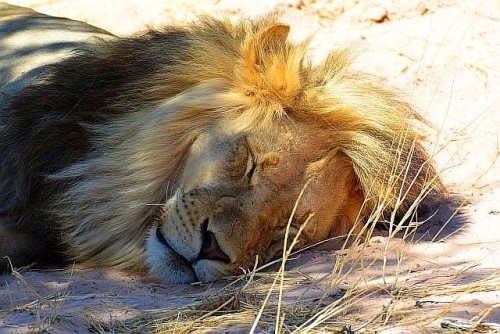








In a semi-arid country like Namibia, where deserts fringe both the eastern and western borders, water is a precious resource. At the onset of summer towards the end of the year, Namibians watch the skies expectantly waiting for the clouds to gather and the first raindrops to hit the parched earth. For such a country, it is no wonder that the symbol of a windmill is one that has been ingrained in generations of Namibians, representing hope and life as it catches the wind and turns, pumping up water from underground reservoirs.
In einem halbtrockenen Land wie Namibia, in dem Wüsten sowohl an der Ost- als auch an der Westgrenze liegen, ist Wasser eine wertvolle Ressource. Zu Beginn des Sommers, gegen Ende des Jahres, beobachten Namibier den Himmel und warten erwartungsvoll darauf, dass sich die Wolken sammeln und die ersten Regentropfen auf die ausgedörrte Erde treffen. Für ein solches Land ist es kein Wunder, dass das Symbol einer Windmühle in Generationen von Namibiern verwurzelt ist und Hoffnung und Leben repräsentiert, wenn es den Wind fängt und sich dreht und Wasser aus unterirdischen Stauseen aufpumpt.

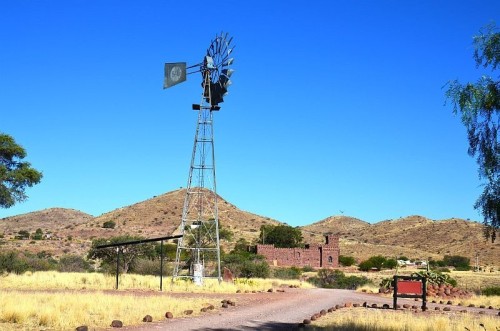











Botswana ist ein weites Binnenland mit einem Umfang von circa 582 000 Quadratkilometern, das von seinen Nachbarn Südafrika, Simbabwe, Sambia und Namibia durch Flüsse getrennt wird, wovon einige nur in der Regenzeit fließen.
Zwei Drittel des Landes bestehen aus der Kalahari Wüste, einer staub verwehten, halbtrockenen, flachen Ebene. Sehenswürdigkeiten sind unter anderem der Chobe Nationalpark, das Moremi Wildtierreservat, das Okavango Delta, die Linyanti Sümpfe, die Makgadikgadi Pfannen, das Zentralkalahari Wildtierreservat, Tuli Block und der Kgalagadi Transfrontier Park. Die Regenzeit ist von November bis April und die Trockenzeit von Mai bis Oktober.
A vast land-locked area of approximately 582,000 square kilometres, Botswana is divided from its neighbours, South Africa, Zimbabwe, Zambia and Namibia, mainly by rivers, some of which flow only during the wet season.
Two-thirds of the country is covered by the Kalahari Desert, a wind-blown, semi-arid, flat plain. Places of interest are the Chobe National Park, Moremi Wildlife Reserve, Okavango Delta, Linyanti Swamp, Makgadikgadi Pans, Central Kalahari Game Reserve, Tuli Block and Kgalagadi Transfrontier Park. The rainy season is from November to April, with the dry period May to October.











Das Okavango Delta gehört zu den erstaunlichsten Landschaften im südlichen Afrika. Das Gebiet besitzt eine reiche und einzigartige Biodiversität: etwa 500 Vogelarten, 128 verschiedene Säugetierarten, ca. 150 Reptilien- und Amphibienarten leben innerhalb und um das Okavango-Delta.
The Okavango Delta is one of the most amazing landscapes in southern Africa. The area has a rich and unique biodiversity: around 500 bird species, 128 different mammal species, and around 150 species of reptiles and amphibians live within and around the Okavango Delta.












Die San, Ureinwohner Namibias, auch Buschmänner oder Bushmen genannt, leben schon seit über 20.000 Jahren im südlichen Afrika. Die Region gehört zum sog. Buschmannland, welches den San von der südafrikanischen Homeland Strategie zugewiesen wurde. Man schätzt, dass heute ca. 30.000 San in Namibia leben, wovon noch 2000 in ihrer traditionellen Weise leben.
The San, the original inhabitants of Namibia, also called Bushmen, have been living in Southern Africa for more than 20,000 years. The region belongs to the former Bushmanland, appointed homeland to the Bushmen by the former South African administration. It is estimated today that about 30,000 San are living in Namibia, of which about 2,000 still have a traditional way of live.












Giraffen sind in afrikanischen Savannen verbreitet. Heute leben sie nur noch südlich der Sahara, vor allem in den Grassteppen Ost- und Südafrikas. Die Bestände nördlich der Sahara wurden frühzeitig durch den Menschen ausgerottet: während des frühen Altertums im Niltal und etwa im 7. Jahrhundert in den Küstenebenen Marokkos und Algeriens. Im 20. Jahrhundert verschwanden Giraffen aus vielen weiteren Bereichen ihres Verbreitungsgebiets.
Giraffes are common in African savannas. Today they only live south of the Sahara, especially in the grass steppes of East and South Africa. The population north of the Sahara was wiped out early by humans: during the early antiquity in the Nile valley and around the 7th century in the coastal plains of Morocco and Algeria. In the 20th century, giraffes disappeared from many other areas of their range.












Keinem anderen Tier bringt der Mensch so viel Achtung entgegen wie dem Löwen. Die beeindruckende Raubkatze steht für Kraft, Schönheit, Ausdauer und Stolz. Und doch ist der Löwe massiv in Gefahr, vor allem durch menschliche Eingriffe. Was unvorstellbar erscheint, ist in einigen Regionen Afrikas bereits Realität: Die Löwen sind akut bedroht!
No other animal is much more respected by humans as the lion. The impressive big cat stands for strength, beauty, endurance and pride. And yet the lion is in great danger, especially from human intervention. What seems unimaginable is already a reality in some regions of Africa: the lions are under acute threat!


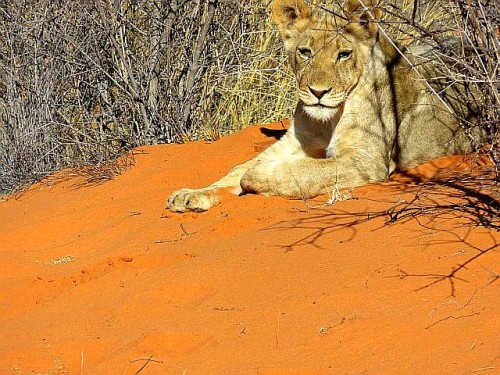


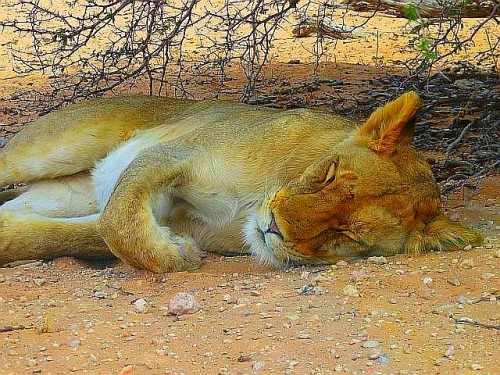
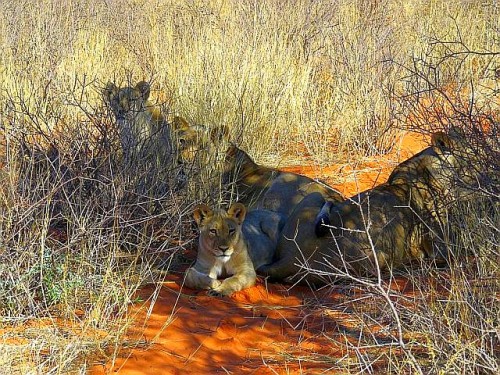
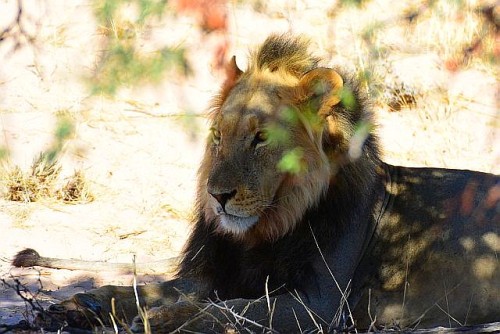


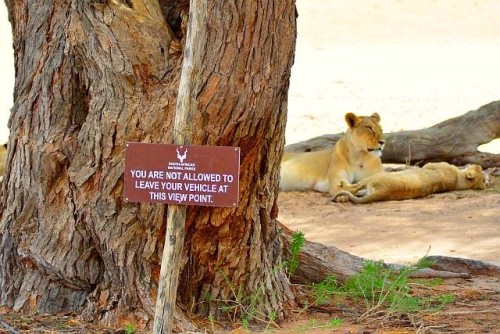


Botswana ist ein weites Binnenland mit einem Umfang von circa 582 000 Quadratkilometern. Zwei Drittel des Landes bestehen aus der Kalahari Wüste. Sehenswürdigkeiten sind unter anderem der Chobe Nationalpark, das Moremi Wildtierreservat, das Okavongo Delta, die Linyanti Sümpfe, die Makgadikgadi Pfannen, das Zentralkalahari Wildtierreservat, Tuli Block und der Kgalagandi Transfrontier Park.
Botswana is a vast land-locked area of approximately 582,000 square kilometres. Two-thirds of the country is covered by the Kalahari Desert. Places of interest are the Chobe National Park, Moremi Wildlife Reserve, Okavango Delta, Linyanti Swamp, Makgadikgadi Pans, Central Kalahari Game Reserve, Tuli Block and Kgalagadi Transfrontier Park.












Botswana ist ein weites Binnenland mit einem Umfang von circa 582 000 Quadratkilometern, das von seinen Nachbarn Südafrika, Simbabwe, Sambia und Namibia durch Flüsse getrennt wird, wovon einige nur in der Regenzeit fließen.
Zwei Drittel des Landes bestehen aus der Kalahari Wüste, einer staub verwehten, halbtrockenen, flachen Ebene. Sehenswürdigkeiten sind unter anderem der Chobe Nationalpark, das Moremi Wildtierreservat, das Okavongo Delta, die Linyanti Sümpfe, die Makgadikgadi Pfannen, das Zentralkalahari Wildtierreservat, Tuli Block und der Kgalagandi Transfrontier Park. Die Regenzeit ist von November bis April und die Trockenzeit von Mai bis Oktober.
A vast land-locked area of approximately 582,000 square kilometres, Botswana is divided from its neighbours, South Africa, Zimbabwe, Zambia and Namibia, mainly by rivers, some of which flow only during the wet season.
Two-thirds of the country is covered by the Kalahari Desert, a wind-blown, semi-arid, flat plain. Places of interest are the Chobe National Park, Moremi Wildlife Reserve, Okavango Delta, Linyanti Swamp, Makgadikgadi Pans, Central Kalahari Game Reserve, Tuli Block and Kgalagadi Transfrontier Park. The rainy season is from November to April, with the dry period May to October.











Botswana ist ein weites Binnenland mit einem Umfang von circa 582 000 Quadratkilometern. Zwei Drittel des Landes bestehen aus der Kalahari Wüste. Sehenswürdigkeiten sind unter anderem der Chobe Nationalpark, das Moremi Wildtierreservat, das Okavongo Delta, die Linyanti Sümpfe, die Makgadikgadi Pfannen, das Zentralkalahari Wildtierreservat, Tuli Block und der Kgalagadi Transfrontier Park.
Botswana is a vast land-locked area of approximately 582,000 square kilometres. Two-thirds of the country is covered by the Kalahari Desert. Places of interest are the Chobe National Park, Moremi Wildlife Reserve, Okavango Delta, Linyanti Swamp, Makgadikgadi Pans, Central Kalahari Game Reserve, Tuli Block and Kgalagadi Transfrontier Park.











































































